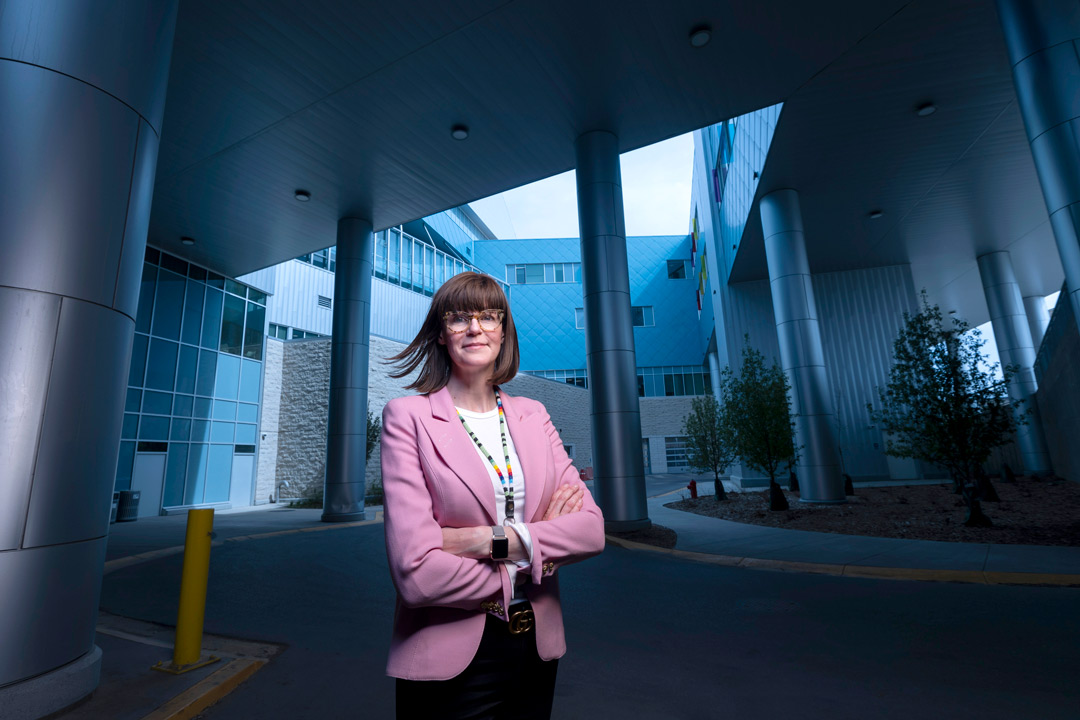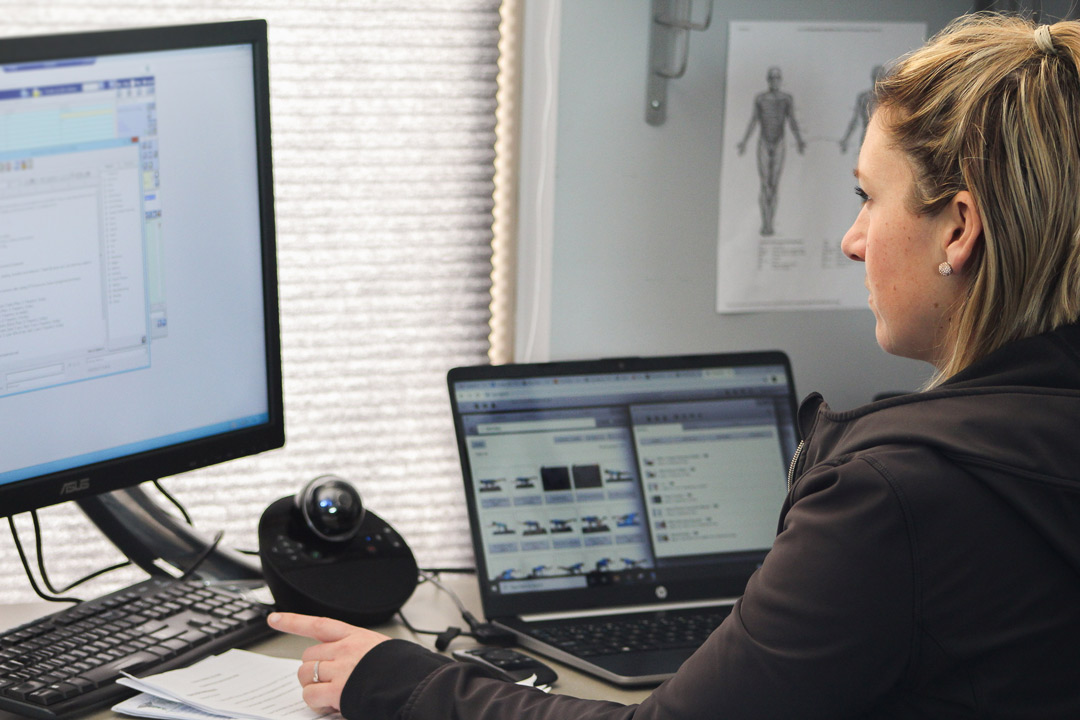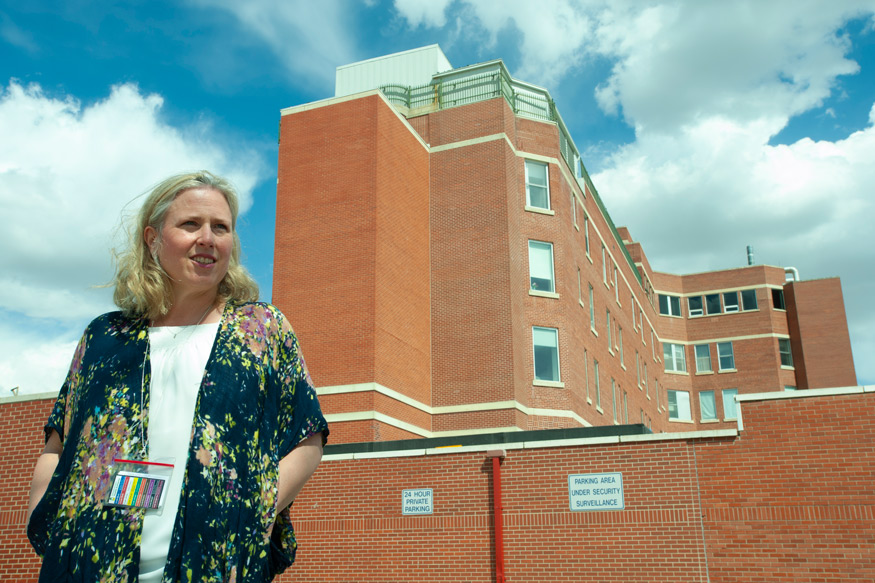The resilience of health-care workers
When everyone was told to stay home, they were putting on their masks. Deemed essential and tasked with the daunting responsibility of keeping their community safe, USask alumni health-care workers have proven their resiliency throughout the COVID-19 pandemic.
By ASHLEIGH MATTERNSeveral members of USask’s alumni health-care family gave us an inside look into their world during the pandemic. While some found unlikely positives with the increase of technology, others noted the impact burnout can have on essential frontline workers.
The Saskatchewan Health Authority (SHA) had a plan in place for a pandemic before the COVID-19 pandemic hit, says Dr. Susan Shaw (MD’95), the SHA chief medical officer. It’s part of the ongoing work of the health authority to have plans for medical emergencies. But in January 2020, that plan became very real.
Shaw provides leadership and direction to physicians and staff who work in the health authority and is responsible for the portfolio of quality, safety, and strategy. Once the pandemic hit, her focus narrowed.
“We now had a single focus,” she said. “Everyone was aligned.”

Along with her leadership role, she’s also a frontline worker — a critical care physician who practices medicine in the intensive care unit (ICU) at St. Paul’s Hospital and Royal University Hospital in Saskatoon.
In the ICU, the core of her work is very much the same — working in a team looking after people who are facing life-threatening illnesses. But the pandemic brought about more infection prevention control steps.
“[COVID] added extra layers of action and thinking to everything we do,” Shaw said.
Because of the increased hours, safety measures, and precautions, she’s worried about the long-term impacts on health-care workers of working under such stress and the additional workload.
“We go into health care because we want to do work that makes a difference in the lives of others,” she said. “That drives almost all of us, and allows us to maintain some resilience... I've seen many people grow and do remarkably well as health-care workers because the work they’re doing has clear value.”
Workers are saving lives, helping people recover from the illness, and trying to prevent infections by testing, tracing, isolating and vaccinating, but she says it’s still “draining, never-ending work.”
Some surveys have shown that three out of 10 health-care workers are thinking of leaving their profession when the pandemic is over, she said.
Shaw said she has anxiety dreams related to the stress and the worry and the planning, and she knows some of her colleagues are having nightmares as well.
There has been a focus on physician and health-care worker wellness throughout the pandemic, though. She said mental health supports are built into the workplace through coaching, resources, and reminders built into daily huddles.
“Physician wellness is part of our physician town hall. We have a working group that’s thinking about this all the way through.”
Another challenge of the pandemic has been providing relevant, meaningful, and timely information to the public. That’s difficult to do in the best of times, let alone when the SHA is dealing with a novel coronavirus.
“That’s really been amplified within the pandemic, trying to get the public the information they need and supporting decision makers in the public,” she said. “We were trying to make sure people had the right information they needed but not being overloaded with updates and reminders and news.”
‘The toothpaste is out of the tube’
While everyone was trying to make sense of the often changing information about the COVID-19 virus, there was also a push to learn new technologies like video conferencing and accessing online health records because of the rising need to maintain social distancing.
Dr. Tracie Risling (BA’98, BSN’03, MN’07, PhD’14), interim associate dean research and grad studies in the College of Nursing, says electronic health records became “hugely important” during the pandemic as a way to access COVID-19 test results.
Risling has a long history with eHealth Saskatchewan as a nurse peer, and with Canada Health Infoway, which is the national support to the pan-Canadian electronic health record. MySaskHealthRecord is the portal into that electronic health record in Saskatchewan.
Risling had been working for many years to help people sign up and access their electronic health records but pre-pandemic, there were still barriers for many people to do so.
“Barriers we thought would take us three to five years to overcome, some of those barriers came down in three to five weeks once it had to be done that way,” she said.
There was a strong collaborative focus on access from the government, health care, researchers, and patients to make it happen, and she feels when it comes to patient electronic health record use, “the toothpaste is out of the tube now,” which is a positive to her as a digital health advocate.
Unfortunately, the pandemic and the shift to more digital technologies has also revealed inequalities.
“We’re not all online. Even if we were all online, our individual capabilities and capacities differ,” she said. The stark representation of that has been on display in the pandemic.”
She had these inequalities in mind when working on a mental health tool that uses texting to deliver resources — the texting tool includes lower-tech options for people who have limited data.
The tool, called Be SaskWell, asks a series of questions to determine if your mental health is languishing or flourishing, then delivers 10 weeks of digital mental health support, including check-ins and wellness tips.
“People all over the world are starting to hit the languishing portion of this pandemic,” Risling said. “There are so many really amazing digital mental health and wellness resources out there that people aren’t aware of.”
The opportunity to develop these types of tools was only possible due to funding available for pandemic-related projects, but the concept can have a life beyond the pandemic.
Business model forever changed
Like Risling, Bruce and Karen Craven also found opportunities in the pandemic, at least once they got over the initial shock.
The Cravens are co-owners of Craven SPORT services, a multidisciplinary sport physiotherapy organization that offers strength and conditioning guidance as well as an integrated health network that includes massage therapists, occupational therapists, dietitians and even psychologists.
Bruce (BSPT'88, BSPE'88, MSc'91) said when the pandemic hit, they took care of their staff first, and then their clients, and then the community.
“If we don’t have a community, we don’t have clients, and if we have no clients, we have no staff,” Bruce said. “We made a lot of decisions based on those three caring things and that still exists today.”
Karen (BSc’94, BSPT’96) said they pivoted right away to develop their own online platform called Craven Connect @Home to start delivering service virtually. The impact of the new tool on their business was remarkable.
“It’ll forever be a part of our business,” Karen said.
It’s a good tool not only for promoting physical distancing but also during unexpected events like a snowstorm, or if one of the clients needs to go out of town for work. Saskatchewan also has long distances between communities, so the online system allows their clients to do some of their work without having to travel to Saskatoon.

It likely won’t replace hands-on therapy completely, because Karen says a big part of their profession is putting their hands on people, but it’s another option. It encourages hybrid models where people can choose between a virtual or in-person session when it’s convenient for them.
One of the challenges with a virtual platform was the legalities — they had to ensure they were in compliance with privacy laws, USask's School of Rehabilitation Science, and basic human rights issues. As Karen put it, they had to make sure they were “dotting all the Is and crossing all the Ts.”
Then there was the general challenge of getting people to adopt a new technology.
“Everyone has had that challenge,” Karen said. “Depending on the generation, it was challenging for people.”
Today, though, there aren’t many grandparents who haven’t communicated with grandchildren through video.
“That’s a COVID gift,” Bruce said.
Re-evaluating care for cancer patients
Unfortunately, cancer doesn’t stop just because of a worldwide pandemic.
Lynn Dwernychuk (BSN'98, MN'13), director of clinical research at the Saskatchewan Cancer Agency, said it’s monumental moments, like working and providing patient care in a pandemic, that allowed her team to shine.
“With the pandemic, we’ve seen a lot of teamwork across the disciplines at the cancer agency and in our health region and at a national level, too as well,” she said.
“It was all hands on deck when COVID hit here, and the team here at Saskatchewan Cancer Agency have been excellent in collaborating with each other and putting processes in place that make it safer for patients and staff.”
The Saskatchewan Cancer Agency operates prevention and early detection programs, conducts research, and provides patient-centred care. The organization operates outside the Saskatchewan Health Authority.
Patients of the Saskatchewan Cancer Agency have also seen some benefits come out of the pandemic, in part because of the increase in online digital appointments, says Dwernychuk.
“It helped us take a step back and look at the work we're doing and reevaluate it,” she said.
People now have the option of virtual appointments using video software called Pexip, a secure web-based program. Previously, they used Telehealth, which allowed patients around the province to connect with their health-care providers in Saskatoon, but still required the patients to go into one of the outreach centres.
Now, patients can stay at home, and Pexip allows patients to include their family or significant others in meetings.
“[It] has been really great for our patients,” Dwernychuk said. “It helps us continue the cancer journey when it’s best for them to remain at home.”
They’re also allowing patients to have bloodwork done closer to their home rather than having it done at the cancer centres, and there was also work done to allow patients to pick up oral chemotherapy medication closer to home, whether at a community or outreach pharmacy, or having it shipped to a home address.
‘Building a plane as you fly it’
An unlikely outlier in the COVID-19 pandemic has been the rise of technological advances within health care settings, a positive bonus in an otherwise bleak situation.
Despite these advances, the common picture inside hospitals around Saskatchewan and the world has been one of exhaustion, resilience, and burnout. Nurses and doctors on the front lines are face-to-face with people infected with the disease, trying every day to manage patient care while keeping themselves safe.
Prior to the pandemic, one of Sherilyn Bray’s (BSN’12) focuses was in harm reduction, working on plans for how to support intravenous drug users, or reviewing plans for a Code Orange — a code called when there are mass casualties.

When the pandemic hit, her role shifted to working with the emergency preparedness team and supporting visitor restrictions.
“It has to be done but it doesn’t fall with anybody,” she said. “Who has the time to roll that out to the broader team?”
Bray is the director and site lead at Regina’s Pasqua Hospital. It’s a new position at Pasqua Hospital, created when SHA amalgamated. The site lead was pivotal to supporting the Code Orange in Saskatoon when the Humboldt Broncos bus crash happened.
These are the problem solvers, supporting all of the services offered at the hospital.
“We run a 24-hour business, and we need support in those off hours,” she said. “We fill in all the gaps between clinical and non clinical.”
Infrastructure problems, like floods or fires, can affect the clinical side, and the site leads along with their site manager team, help manage any issues that come up.
Bray wasn’t the only person whose role needed to shift to meet the new demands of the pandemic. Like Shaw, Bray said many of her colleagues are facing burnout as they continue to combat COVID-19.
“We’re all being stretched,” she said. “Lots of us are being asked to kind of diversify. … It changed my work immensely, and changed the entire organization’s work.”
Nurses, physicians, support service workers, security teams, care aides, lab technicians — all are being asked to work differently.
“We’re learning to diversify and let go of things and take on other things, stand there with our team and be there with them,” she said. “It’s challenging. I’m tired, we’re all tired, and they don’t get to be tired, I don’t get to be tried. We don’t bring our best selves to work. How do you face being stretched thin?”
Bray said guidelines and protocols were constantly shifting and changing. The adjusting and readjusting is a mental strain.
“It’s like building a plane as you fly it. You feel crazy sometimes.”
But she says everyone is working as a team to provide the care people need.
“Everyone has risen to the occasion.”
It’s a sentiment adopted by Shaw as well. She said she feels fortunate to be in Saskatchewan because of the partners across the health-care system, including USask colleagues.
“Coming together around a common issue where everyone has wanted to help is really important to the ongoing response,” Shaw said. “It’s been a team effort.”


